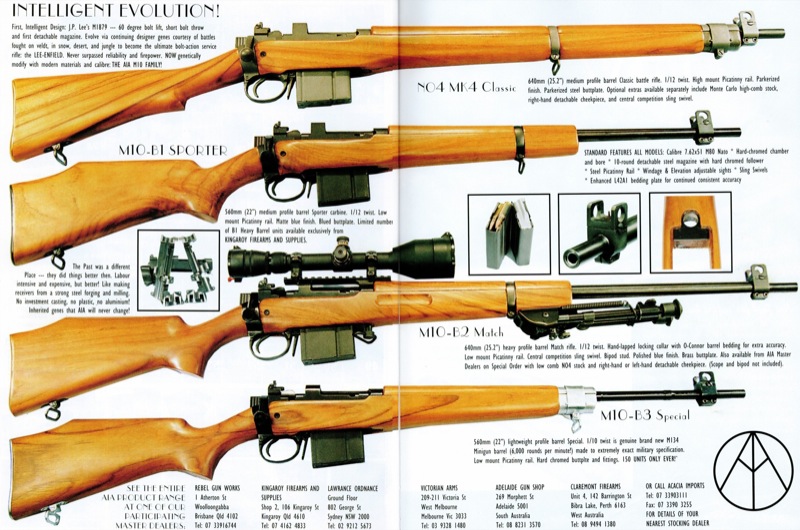
Thread: Photos of #4MK1 converted to 7.62 Nato
Retrieved: 06/03/2014
Does anyone have any close up photos of the changes made to the #4 action when converted to 7.62 NATO? Any reasonable changes that produce a working rifle are welcome official or not.
I am interested in photos of the bolt, bolt head, bolt face view, ejector changes, magazine changes and any modifications to the receiver.
tiriaq
06-28-2009
No mechanical changes to the bolt, or bolthead. Boltheads used for 7.62 were proofed at a higher level in the UK.
The Sterling conversion system added an ejector through the left receiver wall, the L42s had an ejector built into the left rear magazine lip.
Front of receiver may be opened out a bit. Canadian DCRA conversions retained the .303 extractor, the Brits installed a 7.62mm one. Canadian conversions were intended to be single shot.
Alfred
06-28-2009
Don't know how much help this might be but here's some things I found when trying to figure out the best way of getting some use out of the out of spec Lithgow No.1 I've mentioned before.
This particular rifle's action had some anomalies that had me stumped when trying to use it as is before junking the badly eroded barrel.
The extractor spring had been replaced with a coil spring set up, this I later found to be a feature of some deactivated drill rifles, the weaker spring was part of a set up for keeping spring tension on the bolt head when cycling the action but not being usable for extracting fired live rounds.
The rifle would not extract that way so I installed a replacement V spring.
Then I found that the extractor held the rim of a fired .303 case too tightly for proper ejection and pushed it hard over against the grooves in the receiver wall with more force than necessary causing it to pop loose and fall back into the feed way.
The extractor looked different from those of other No.1 extractors.
I then tried cycling some dummy and some empty 7mm cases through the action, not far enough to chamber of course. The rifle fed the rimless cases perfectly and extracted and ejected them perfectly.
I checked several other case types and empty 7.62 cases. The later fit with this out of spec bolt head and extractor perfectly.
I began to suspect that the non matching bolt or at least the bolt head might have been a leftover from the failed Lithgow 7.62 experiments. Not that likely though.
Most 7.62x39 conversions, with its smaller diameter rim use a modified bolt head with silver soldered rim on the bolt face, There doesn't seem to be enough room for such a counter rim if cases like the .308 or mauser type are used. It would just interfer with ejection anyway.
You might check on whether BSA Sporters were available in rimless chamberings, I think there were a few.
Thunderbox
06-28-2009
At the basic level, a No.4 can be converted to 7.62mm/.308 just by screwing in a barrel.
Many, many target rifles had no other changes whatsoever - they used the existing .303 magazines and extractors (about half of all such rifles with a .303 extractor will in fact eject 7.62mm cases - and all rifles will extract the round).
As tiriaq says, its fitting of a 7.62mm magazine which may or may not require further changes. A Sterling magazine will fit any unmodified rifle, but an Enfield magazine requires the underside of the bolt rails to be of such dimensions that the ejector tab on the magazine lip enters the boltway in just the right location. A few rifles can take an Enfield magazine without modification, but most require adjustment.
Alfred
06-28-2009
A standard .303 magazine can probably be modified to hold and feed the 7.62 cartridge, The unmodified No.1 magazine worked fine with 7mm Mauser dummy rounds.
Probably better in the long run to fit a 2A magazine or aftermarket replacement 2A mag.
The proof marks on the L42 bolt suggest that it might be wise to have a converted Enfield re-proofed. I've seen enough damaged .303 No.4 Enfield bolt bodies that were probably subjected to similar pressure levels by use of MkVIIIZ that I would not assume that a bolt or bolt head proofed at the lower 18.5 would hold up very long to the similar higher pressure of NATO ball.
There are warnings posted on a number of manufacturers sites listing Mil surp 7.62x51 ammo types that are known to damage recent production high quality rifles that digest better quality NATO ammo with no problems.
It would be best to look into these and make a list of ammo types to avoid.
ireload2
06-28-2009
I would not shoot a converted #4 rifle with any significant amount of factory ammo. At most a few rounds to compare case head expansion. Other than that my handloads would just be starting level .303 loads in the 7.62 military cases since they are so close in capacity. I suppose if I needed a repeater I could put an insert into an old Lee-Enfield magazine that provides for a few rounds fed in straight line fashion.
An interesting conversion might be named a 7.62x56R British Match.
Just use a .308 groove diameter barrel and a chambering reamer that matches US SAAMI mfg .303 brass with maybe .002 to.003 body clearance and a very close fit at the base and shoulder.
It would look like a .303, feed like a .303, the brass would last longer than a .303, it would use .303 brass and use .308 diameter bullets.
Further more the headspace could be set up close to zero with US SAAMI brass using a modified "0" bolt head. The bolt head could be ground -.010 and be so marked. This would permit change to a modified -.005 bolt head if required before going through the normal bolt head steps. However at least the way I load a Lee-Enfield I would not expect to ever change bolt heads.
Once these changes were made brass would last longer and common bullets could be used. Sorry non-reloaders are not invited. However as surplus .303 barrels dry up this would been one way rehab rifles with worn and corroded bores and keep them shooting.
I wonder if the British military match shooters ever got scammed by a cheater using such a rifle and ammo.

Alfred
06-28-2009
Theres a 7.7x54R cartridge used in modified No.4 rifles in France. A similar cartridge was developed in Australia.
This shorter version of the .303 allowed barrels to be set back two threads, headspace brought back to proper limits if need be, and the chamber freshed out with the properly ground reamer. A tight match grade chamber was possible then.
The French used this method so they could own an Enfield military rifle in a non military caliber, the Australian version was meant to sidestep legislation against owning a military caliber rifle. Thats no longer an issue in Australia, but I've seen FN FAL styled single shot 7.7x54R rifles that were built in those days for match competitions.
Anyway I think you'll find that there are plenty of high quality .311 bullets available, not many sources for .311-312 barrels though.
I wouldn't be supprised if there were Finnish sources for match grade barrels, though many of their 7.62x54R rifles were rebarreled or manufactured with .310 and even .309 barrels.
I did find a company said to produce match grade barrels in every possible bore size, but its prices were a bit stiff.
In the 60's many custom rifle makers used surplus .30 caliber Browning MG barrels that they turned as barrel blanks.
With the numbers of full auto owners out there now days I doubt these can still be found that cheaply.
You can read Reynolds' Lee Enfield book, a PDF is available on this site.
He tells a lot about the various accuracy issues with the oversized bores and undersized bullets, and the odd practice of lapping the last 14 inches of bore oversized to allow the MkVI ammo to give the same velocity from the SMLE barrel as from the Longer LE barrels, how that worked is not that clear.
I'm just pleased my 1915 MkIII has a tighter bore than most, a true .311, though I suspect that means it was rebarreled at some later date.
I've been told that in order to tighten head gap clearance by several thousandths only requires turning the barrel in a few degrees further than it is. This would be a problem with the No.1 due to the sights. and the No.4 to a lesser extent, due to the extractor cut. A widening of the extractor cut might allow the barrel to be over clocked, the lugs on the barrel can be filed on one side and shimmed on the other.
Many No.4 rifles I've examined had a visible gap between the breech of the barrel and the bulkhead of the receiver ring, so they were never properly screwed down tight to begin with.
A better conversion in .308 bore size would be the .300 Savage, the forefather of the .308. 7.62 magazines should work okay. .30-40 Krag has been suggested as well.
I like the original .303 better, and its easier to rectify headspace issues to make a .303 work at its best than to start a whole new set of problems with a conversion.
ireload2
06-28-2009
>>>I like the original .303 better, and its easier to rectify headspace issues to make a .303 work at its best than to start a whole new set of problems with a conversion.<<<
I have reloaded for 3 of these rifles and all had very nice bores. All of them gave poor case life with neck sized brass. What are the probabilities that all 3 had head space problems. Any changes I might make are just as much for the educational value as for the shooting value.
I think the .300 Savage would be almost the worst of all worlds.
The .300 Savage brass is getting hard to find and it is small at the head too.
I have no idea where anyone could find an affordable 7.62 Lee-Enfield magazine.
The Dutch were not happy with their 6.5x53R cartridge especially for their machine guns. They came up with a an 8x57R that was supposed to be an original Dutch cartridge though I have never been able to find any hard documentation of it. There are accounts of their machine guns being converted to it. The Dutch 8x57R was basically supposed to be a .303 British necked up to 8mm.
>>>Many No.4 rifles I've examined had a visible gap between the breech of the barrel and the bulkhead of the receiver ring, so they were never properly screwed down tight to begin with.<<<
My rifle has a gap at the rear of the barrel face and the receiver. They are easier to make this way since my receiver would require a counterbored breech face otherwise. In addition the gas vent hold will not have much of a function if the barrel face is solid against the receiver. The gap acts as a duct for the gas to exhaust out the vent hole.
Alfred
06-28-2009
Originally Posted by ireload2
The Dutch were not happy with their 6.5X53R cartridge especially for their
machine guns. They came up with a an 8X57R
Some Dutch rifles were rebored to .303 as well, a rare conversion occasionally encountered, most were believed lost to sub attacks in transit.
Rimmed cartridges seem to have worked better in the earlier belt fed MG designs.
A few Mauser carbines were converted to .303 for use by European machinegunners armed with WW1 surplus Vickers guns. Another very rare conversion that used a slanted box magazine developed for British sporting rifles built on the Mauser actions.
BTW, I think you mentioned finding a discarded Benchrest or other target barrel and cutting it back at the breech for this project.
Thats not a bad idea at all.
Shooters that have set back, rethreaded, and rechambered barrels with eroded throats have found that the tapered bore effect from mechanical wear gives a much better bullet to bore seal all the way up, reducing variations in velocity due to blowby.
Some target shooters discard a barrel after only a few thousand rounds, set back and rechambered they can still have tens of thousands of rounds of accurate life. Often at a higher level of accuracy than when new.
You may find a rifle maker that has usable take off barrels at a price far below that of a new blank.
I had considered getting a new condition 7.65 Mauser replacement barrel, at one time these were to be found very cheap, and having it set back in this manner, but the diameter drops off just last the shoulder and theres not enough metal there to cut threads for an Enfield receiver. Bores of the 7.65 turned out to be as oversized as most Enfields.
No.4 five groove barrels I've slugged seldom exceeded .313 with most at .312.
No.1 barrels generally slugged .314, mine is the only .311 I've found so far. Reynolds wrote that barrels as tight as .310 had been among those used in tests on the effect of various bore sizes with varied bullet diameters, the .312 bullet and .310 bore gave the best results.
With headspace corrected loose fit in the chamber is greatly reduced, most of the looseness is due to the steep taper of chamber and case.
I mark the rim of each case and rotate 180 degrees on second firing. This centers the case from then on.
I neck size only about the first 2/3 of the neck, the unsized rear portion of the neck acts to center the bullet to the throat, the evenly expanded case centers the primer to the firing pin. Even with a worn two groove barrel I manage consistent Sub MOA groups. I used .312 bullets for the two groove bore, and 4320 powder.
ireload2
06-28-2009
My most recent shooting was done with mostly some left over Accurate Arms 2495. It was made in China and smells like phenol (moth balls). I was using a mixture of brass with some old Herter's bullets. Not too accurate.
My previous shooting with HXP brass, 4320 and 150grn Hornadys (so old they were black) gave pretty good results though I was mostly adjusting the Redfield sight I bought several years ago. The sight mounts on a no drill side plate and is probably worth more than my rifle.
I think retired bench rest barrels are unappreciated. Many BR competitors retire the barrels after 600 to a couple thousand rounds. When retired these barrels are still shooting better than most military barrels would when new.
Before I pull the barrel off of my rifle I have some brass that I can use up.
Some of it is .444 Marlin brass. I may try some more .405 brass just for testing purposes. After that I may find a .30 caliber barrel for some experimentation.
A 7.62 chamber would leave me with a single shot or more work to make it a repeater. A tight .303 chamber in a .308 barrel would make it easy to reload and I would have a magazine rifle when I got through though it would be .303 look alike wildcat.
whiterider
06-29-2009
They can be made up to be a very satisfactory rifle for service shooting competitions... particularly in countries where only bolt action rifles are allowed for civilians.
I've used them for many years for that purpose. Mine have Sportco (Australian) barrels, made up to replicate the 'issue' 303 profile. Its worth while finding the special extractor which is a little wider than the 303 item and beveled. If you cant find one though by a little brazing and fiddling the 303 one can be made to work.
Magazines? Initially I had the Enfield ones, which do require some matching/relieving of the bottom of the action so they will seat high enough to feed the rounds.
Eventually though i went to the Indian magazines made for the 2 (2A?) rifle... looking like a cut down SLR (L1A1) magazine. Again, some tweaking of the mag lips but they are a much better job than the Enfield ones. Ejector screw needs to be moved about 1/2 inch forward for best results.
Clip/charger loading? I know there was a sheet steel insert on the original L8s but I've never seen one in this country. By selecting your chargers you can find some of the 303 ones that hold the 7.62 round securely enough as long as you make sure the bases of the rounds are pressed back into the charger.
Otherwise expect to make up a lot of 'dummy' rounds (no powder or primer) and just work at it till you get the thing to feed and eject reliably... then with the right projectiles you'll have a rifle that will beat a 303 any day of the week... particularly at long range... :-)
villiers
06-29-2009
...then with the right projectiles you'll have a rifle that will beat a 303 any day of the week... particularly at long range... :-)
Funny that... my .303 No.5 better at 300 metres than at shorter range. I've been wondering why. Been told that the bullet takes longer to stabilise from the shorter barrel. (??)
But the No.5 in .308 is definitely better. Even the mag, chargers and the ramp provide a better feed. The .303 is better at speed. Suppose because the chamber is looser.
Alfred
06-29-2009
Could be that the rim drags on the case body of the following round as it is stripped from the rear feed lips.
Yaw is a funny thing and the MkVII bullets weren't known for stability out of the gate, hence massive wounding effect at short range, and at extreme range were stability fades, while midway the wounds were not worse than other ball.
A friend has owned his No.5 since he was twelve. He can work the action so fast, firing from the hip, that it sounds like a greasegun. Its an unmodified .303.
The shorter flat base 150 grain Hornady shows no sign of yaw from my No.4, but some European boat tail ammo I tried keyholed every shot, though the keyholed rounds still printed a fairly tight group at one hundred yards. That was the only ammo that caused any problems. Can't remember for sure but I think the headstamp was Kraeuter, which is odd because I have a tool box with the same name printed on its lid.
tiriaq
06-29-2009
.30-.303 has been done.
.30-40 Krag is also an option for a .30 calibre Lee Enfield.
ireload2
06-29-2009
.30-40 Krag brass is basically headed for a dead end. So far as I know it is only available from the 2 US companies.
There are many makers of .303 ammunition. At least 4 in the US and 3 in Europe that I can think of without any research.
ireload2
07-01-2009
>>>Funny that... my .303 No.5 is better at 300 metres than at shorter range.<<<
I have seen long running raging arguments where very experienced reloaders and shooters say this can't be possible. They cite the logic "Ok how do the bullets know when to start steering themselves back toward the point of aim to give a closer group. The point is the groups are not smaller but they are less MOA. Since it is not really possible to deal with logic flawed in that manner I just tell then to talk to the technicians at Sierra Bullets. One of their techs cited a specific 6.5 Sierra Matchking that can shoot smaller MOA at longer ranges. The bullet is so long that it takes a while for it to go to sleep. That usually causes the thread to come to dead end.
Of course the arguments also result in me getting called a few names because I also have a rifle that does that. It is a .25-06 that shoots smaller MOA at 200 yards than at 100 yards.
Alfred
07-01-2009
Of course the arguments also result in me getting called a few names because I also have a rifle that does that. It is a .25-06 that shoots smaller MOA at 200 yards than at 100 yards.
Thats the way I'd figured it as well.
Not smaller in inches but smaller in MOA.
tiriaq
07-01-2009
This might be an interesting experiment:
Place a 100m aiming mark. Arrange a sheet of onion skin paper so that the group will form on it.
Place a second screen behind the first at 200m - or 300m. Whatever.
Fire a series of shots. Measure the group in MOA on the 100 and 200 screens. Same shots form both groups. Would make group MOA size directly comparable.
ireload2
07-01-2009
One of the other things that came up as a cause of MOA decreasing with distance was the parallax setting of a rifle scope. Perhaps it would be set wrong at the short range and be set right for the longer range.
BTW the Sierra technician I spoke to was Paul Box 1.800.223.8799
villiers
07-02-2009
VERY interesting article on the subject of LE MOA differences at longer & shorter ranges in the latest edition of the UK web shooting mag:
Target Shooter
[main site]
So now I'm a bit closer to understanding why my .303 No.5 is a lot better at
300 metres and useless at anything under 200m.
Alfred
07-04-2009
The article in Target Shooter was very helpful. I'd read of this compensation factor before many years ago and had completely forgotten it.
As for Yaw
I've used only flat base 150 grain for my reloading, aside from a few experiments with 180 anf 215 grain also flat base.
The short 150 bullets don't seem to be as much affected by yaw.
Yaw with longer bullets can be pronounced, and is given as the reason AP bullets penetrate better at two hundred yards than at 50 or 100 yards. The bullet nose being settled in and striking dead on by then, rather than at a few degrees off center.
ireload2
07-04-2009
>>>Can get some pics of No.4 Mk 2 have two of them Used as target rifles one is a Sterling conversion, the other I dont know but a match trigger has been installed, have to say who ever did this, it is a work of art.<<<
bigduke6,
I would especially enjoy seeing a photo of the match trigger if you have
any.
I have never even seen a photo of the #4 Mk2 standard trigger so I don't know how they were mounted.
villiers
07-05-2009
.303 accuracy gain at longer range
My theory was that the bullet left the barrel and spiralled in a cork screw fashion until it was stabilised by its spin. Thus, it struck the target randomly at shorter distances until the spiral was reduced by the spin on the bullet, and it was better stablilised at about 300 metres.
BUT the article ".303 Compensation Characteristice and Commercial Ammunition" provides a differerent and more likely explanation.
Target Shooter
[main site]
tiriaq
07-05-2009
The "compensation" properties of the Lee Enfield was relevant to the use of service ammunition. The vertical barrel vibration pattern, coupled with velocity variations in service ball resulted in a reduction in vertical stringing at long range. Compensation did not reduce the lateral spread at all, only the vertical.
As long as issue ammunition was used in competition, a Lee Enfield could have an advantage over, say, a P-14, at long range. The list of approved SR(B) rifles was short - SMLEs, No.4s and P-14, for Bisley and Commonwealth competition, in the post-WW2 period.
Some competition shooters would use one rifle for the shorter ranges, to 500 or 600y, and then a Lee Enfield for the long ranges, to 900y. A P-14 might outshoot a Lee Enfield at the shorter ranges.
After it was no longer necessary to compete with a service pattern rifle, and target rifles in 7.62 were being used, some shooters still used a No.4 based 7.62 rifle for the long ranges. This continued into the 1990s.
Once service ammunition was no longer mandatory, and commercial and handloaded target ammuntion became standard, the Lee Enfield target rifles disappeared from competition almost overnight. With consistant, quality ammunition, Lee Enfield compensation was irrelevant, and the superior grouping potential of other target rifles rendered the Lee Enfield obsolete for competition.
Alfred
07-05-2009
Originally Posted by villiers
My theory was that the bullet left the barrel and spiralled in a cork screw
fashion until it was stabilised by its spin. Thus, it struck the target
randomly at shorter distances until the spiral was reduced by the spin on the
bullet, and it was better stablilised at about 300 metres.
There's a diagram of bullet flight in one of my old books that suggests very much what you've said. This was in relation to US service rifles and had nothing to do with the SMLE rifles.
bigduke6
07-05-2009
I have never even seen a photo of the #4 Mk2 standard trigger so I don't know how they were mounted.
Lot of pics to get through so will keep it short, pics based on the difference between the Mk 1 and 2 trigger also info on the 7.62mm conversion by Sterling and an intreesting Match trigger conversion.
Start off with the main difference between Mk1 and 2 actions:
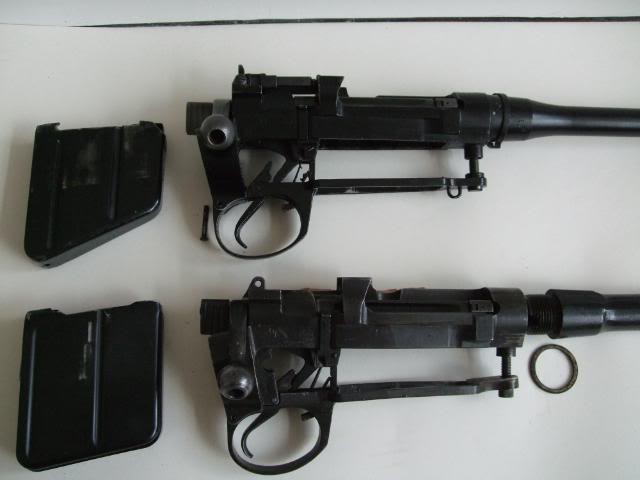
Mk1 below with the trigger gaurd on and off:


Next is the Mk2, guard on and off:
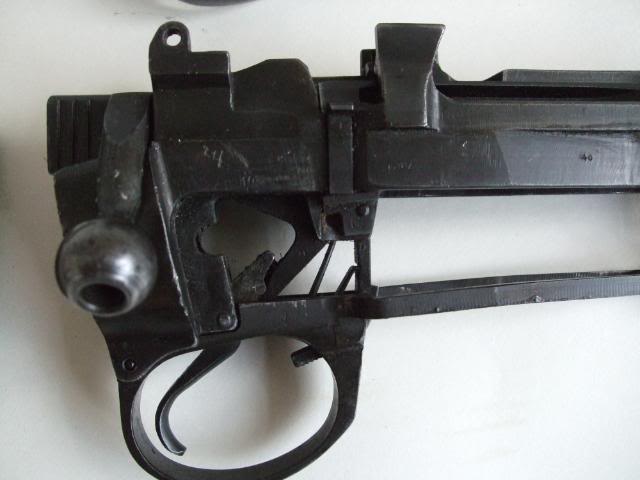

Below shows trigger guards, the Mk1 above and the Mk2 below:
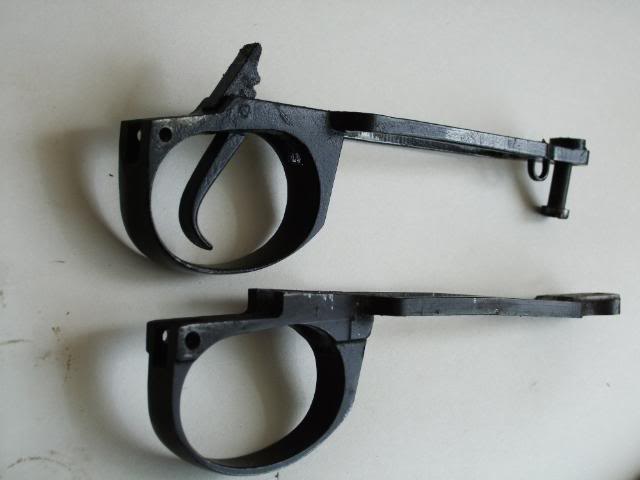
As you can see the main difference was the the Mk1 had the trigger mounted in the guard and the Mk2 had the trigger installed on the wrist.
Next group of pics based around the .303 and the 7.62mm. I will start with the mags and then barrels.
I am only providing the pics and a brief outline, regarding military conversions etc, I will leave to the experts.
Below shows the Sterling conversion mag this would of been purchased in a kit with a barrel (7.62mm ) and would come with a selection of spacers to be able to allow for a good fit and align the Knox form up with the action:
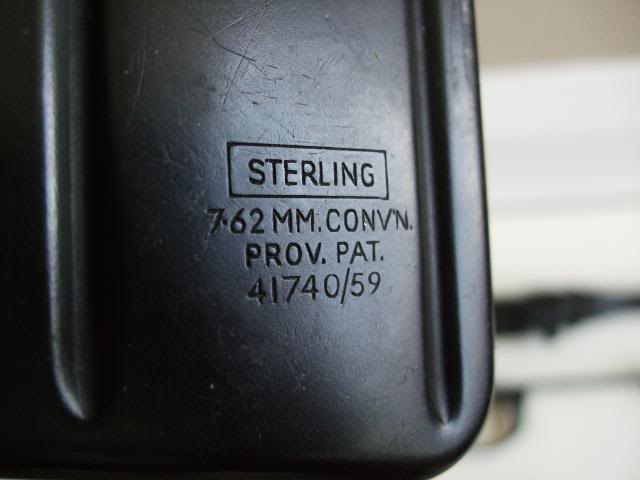
Below shows the .303 and 7.62mm (right):
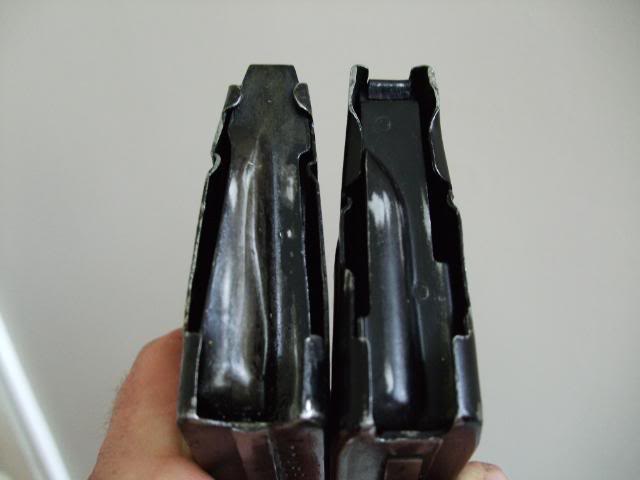
Next up are the difference in the barrels, the basic difference is the protrusion of the 7.62mm case, again I am not going into a full history of the conversion.
Below the standard .303 No.4 barrel (left) and the 7.62mm conversion barrel:
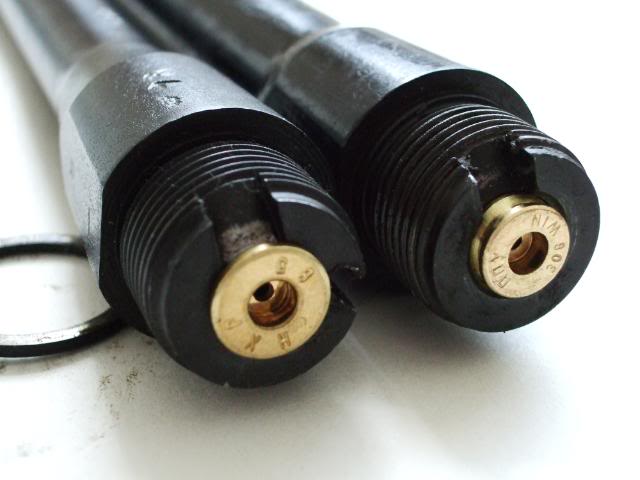
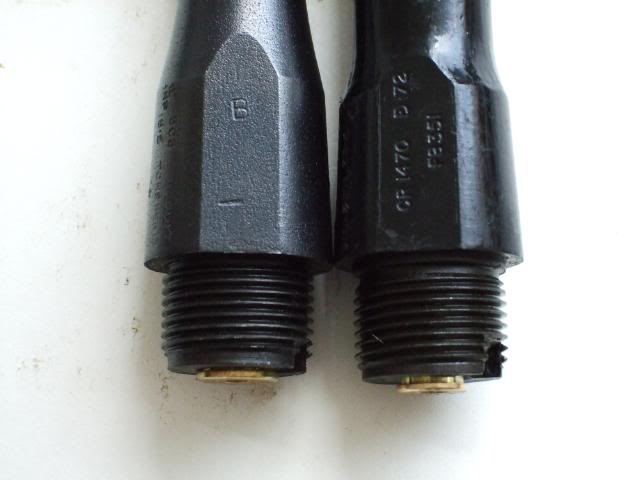
You can see above the length of the tenion of 7.62mm (right) is longer from the shoulder this is to allow for the correct spacer to be fitted. The reason behind the spacer as I am led to believe was, simplicity, as the conversion come in kit form it offered anybody within reason to fit thier own barrel with success with out the need of a lathe and chamber reamers. (head space gauges and maybe a spare bolt head would be needed)
Below (sorry about pic but you can make out the spacer fitted to the 7.62mm):
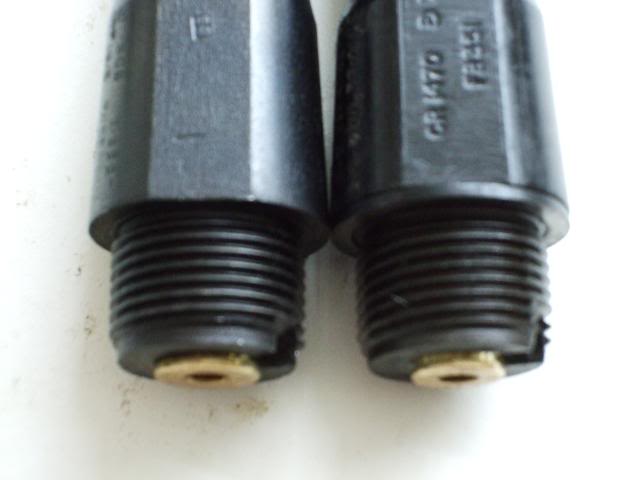
Pic below to show no change in the bolt head and extractor, top .303 bottom 7.62:
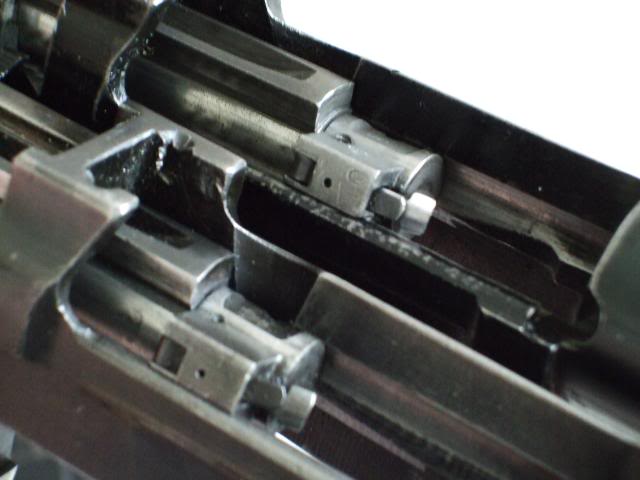
The only problem on these conversions were the ejection of the spent case, The Mk2 in these pics was my rifle, sometimes the case would eject if the bolt was operated at speed but on most ocasions it was the fingers what got the case out.
Modern conversions now are done in house, so the barrel is produced for that action, and the extraction is overcome by altering the bolt head with a plunger built in and a modified extractor.
My last pics are the conversion of a Mk2 action with a match trigger fitted. I have compared this with the prevous Mk2 action. Also please look at the last pics showing the detail of the cocking piece which was machined to suit, also the pics showing the difference regarding the travel of the firing pin when cocked. I have kept this action/ barrel as i have shot it and was very accurate.

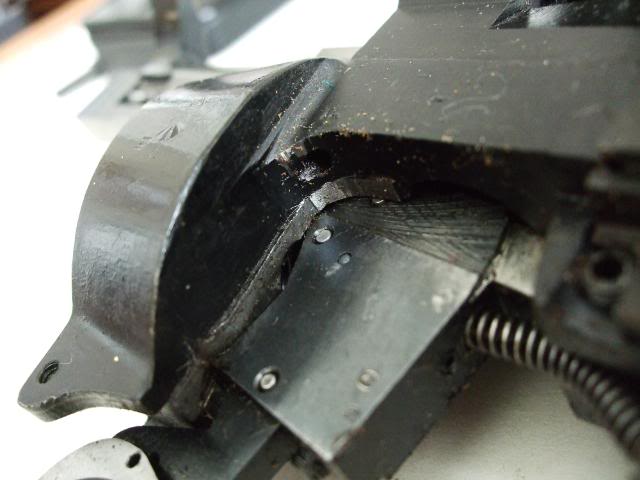

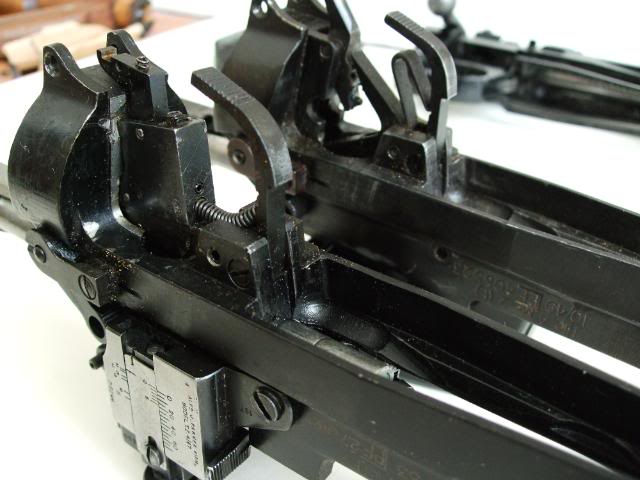
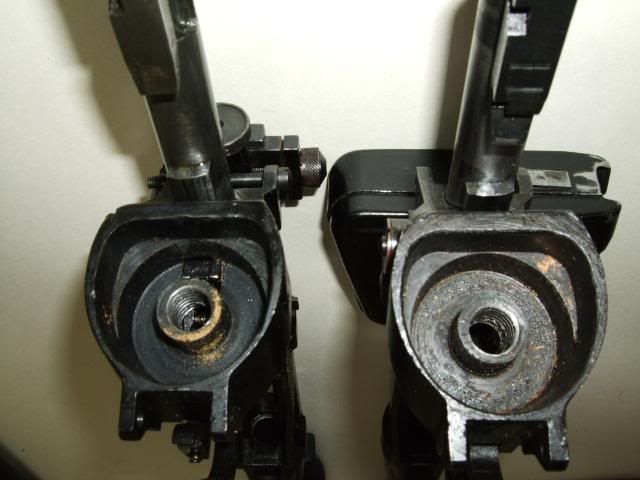

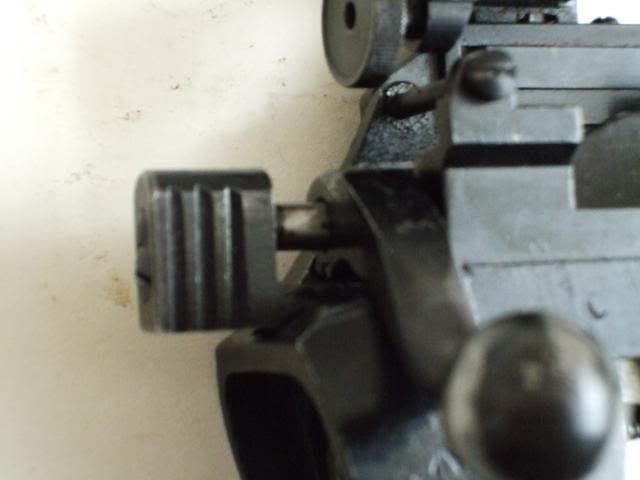
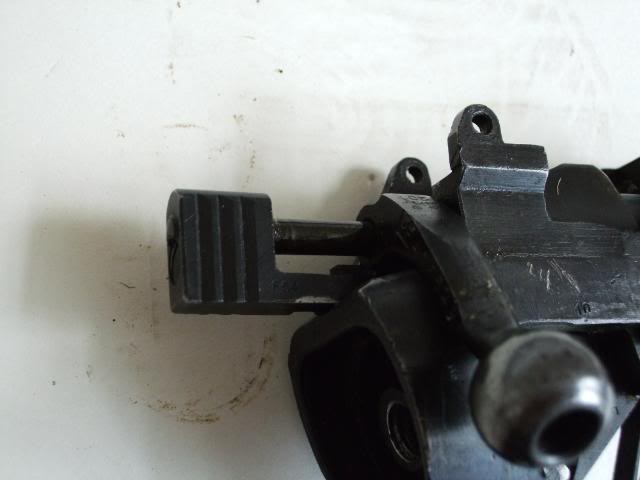
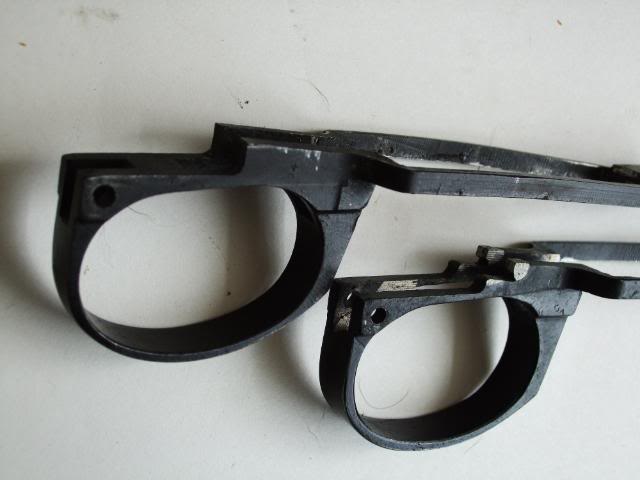
And finally, off the subject the pic below shows a pistol grip which i made and fitted this was only done to prove someone wrong they said "you cant fit a pistol grip to an enfield" so i did, the stock bolt holds it in position and the bar is extra support.
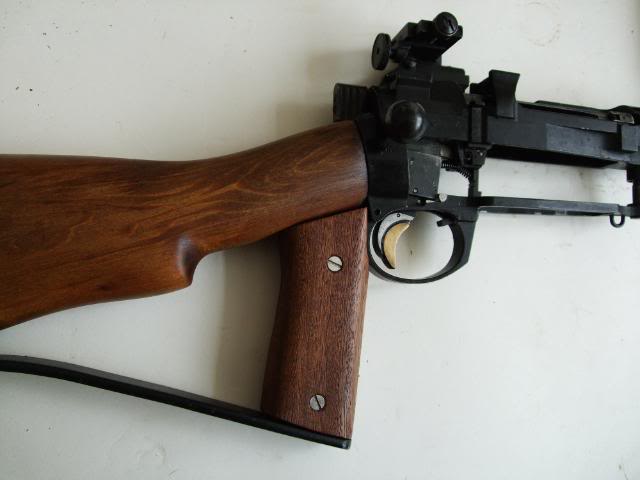
Please note, The above thread is for illustration and general knowledge only. It is not my intention to promote the conversion of a servicable milsurp rifle, if I can restore a bubba'ed rifle I will, if it's a bad case of bubba at work (see my thread on the No.1 MKV) or a standard sporterised with drilled action to take mounts etc., I will restore as a shooter or convert to a pistol calibre (.45 ACP).
ireload2
07-05-2009
bigduke6,
Thanks very much. This was far more comprehensive than I ever expected.
This is worth archiving somewhere.
Is the mainspring in the rifle with the custom trigger stronger than a normal #4 main spring?
The custom trigger housing has some striking similarities to a Canjar single set trigger that I once owned.
In regard to your restoration of a #1MKV, I passed up a twin to yours about 10 years ago. It was offered for sale by an Aussie (living in the US) for $175. The action had not been drilled or modified. The barrel and wood had both been cut. I had no idea where I could have found the wood in this part of the world. I have always regretted passing on it. But at lease I can say I have actually seen a real MkV.
tiriaq
07-05-2009
I have a 7.62mm target rifle built up on a C. No.7 Mk.I receiver, set up as a single shot in an early one piece Robertson synthetic stock. Schultz & Larsen barrel. A Canjar trigger has been fitted, in a manner similar to the target trigger installation illustrated above, and the action has been speedlocked in a similar manner. The mainspring is very stiff compared with a standard Lee Enfield. I believe the gunsmith was named Collins. Apparently he did a number of conversions of this sort.
Becasue I am on dialup, I have given up trying to post photos, but I could take photos and email them if anyone is interested.
bigduke6
07-05-2009
The spring is only for the mag release so strength not as critical, as the original, which was dual purpose and served trigger and mag release.
tiriaq
07-05-2009
I referring to the firing pin spring. Closing the bolt and cocking the rifle requires a good push.
In a box of odds and ends from an auction, I found a couple of single shot trigger guards - just a plain narrow bar running up to the front guard screw, and some single shot adapters that replace the magazine catch. The outer end of the trigger spring engages the adapter, the adapter fills the bottom of the receiver and makes a loading platform.
villiers
07-05-2009
Spin
"I have seen long running raging arguments where very experienced reloaders and shooters say this can't be possible. They cite the logic "Ok how do the bullets know when to start steering themselves back toward the point of aim to give a closer group."
Anyone who's been on the receiving end of a good spin bowler will have first hand knowledge of the fact that the ball can (and often does) deviate, only to adopt devastating accuracy when it hits the wicket.
ireload2
07-07-2009
bigduke6,
Is your trigger a single set type?
Have you ever tried pushing the bottom of the shoe forward to see if it will set?
�